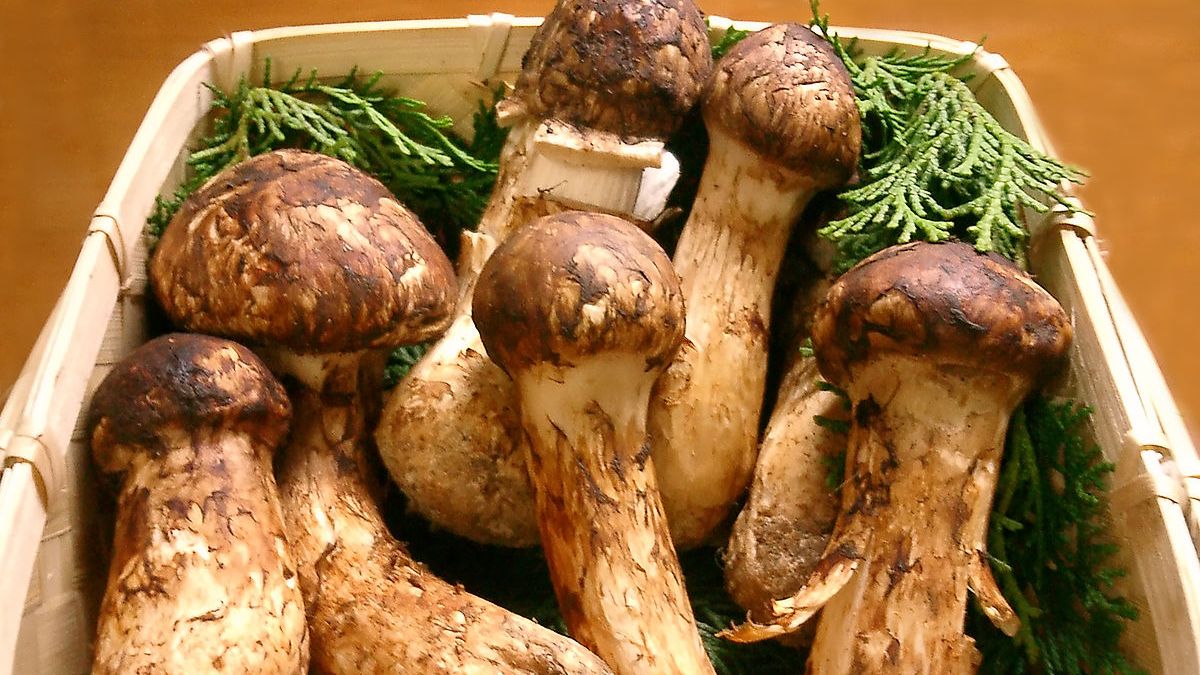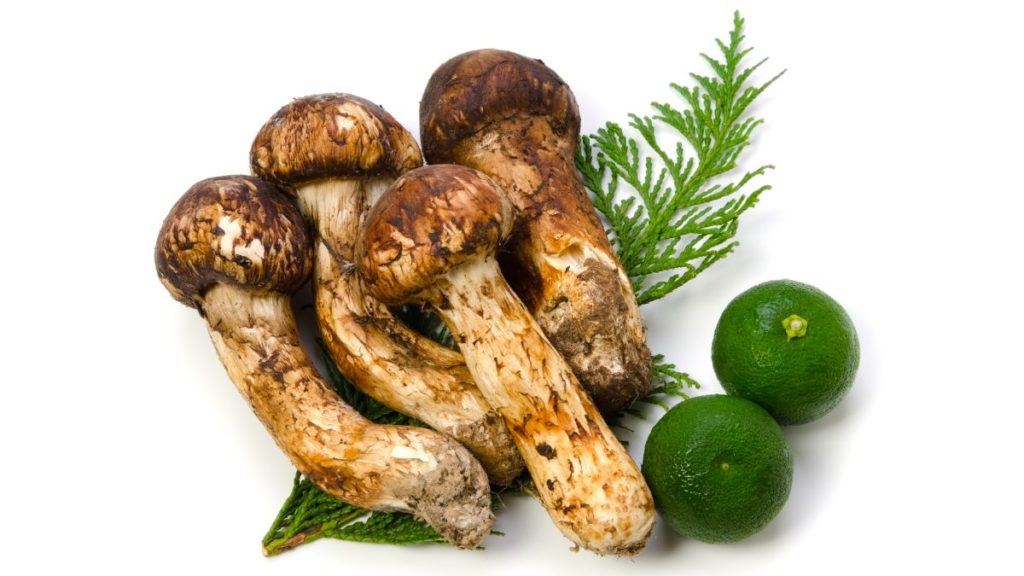Matsutake mushrooms are a kind of wild mushroom that people like to eat. They are known for their earthy, spicy flavor and thick, stringy white flesh. They grow from early fall to midwinter in some parts of Asia and the western United States.
What is Matsutake Mushrooms?
Matsutake mushrooms (Tricholoma matsutake) come from Japan. They grow wild in Japan, China, and Korea. In Japanese, “matsutake” means “pine mushroom” because these fungi grow in pine forests. But the mushroom is in danger in Japan and Okinawa because development is taking away its habitat, and nematodes in the soil are attaching the roots of the trees it needs to grow.
Tricholoma magnivelare and Tricholoma murrillianum are related species that grow in the same kinds of forests in the Pacific Northwest of the United States and some parts of Europe. They are also often called matsutake and sold under that name.
Because they are so rare and can’t be grown like other mushrooms, matsutakes can cost anywhere from $40 per pound in the U.S. to $2,000 per pound in Japan for very rare and high-quality varieties. They are a very important ingredient there and are often given as gifts.
How to Cook with Matsutake Mushrooms?
Wipe matsutakes with a damp paper towel to remove any dirt before cooking. Don’t wash or submerge them in water. Cut the tough caps and stems into thick cubes, slices, or coins to keep the taste and texture.
Like other specialty mushrooms, matsutakes can be steamed, sautéed, seared, roasted, grilled, or cooked in a clear broth. But because matsutake mushrooms are so rare, expensive, and have a unique taste, you’ll get the most out of your money if you treat them gently and let them be the star of whatever you’re making.
In Japan, matsutake mushrooms are usually used to make matsutake Gohan, a popular rice dish in which the mushrooms are cooked with rice in dashi so that the rice takes on the earthy, spicy flavor of the mushrooms. They are also used in the Japanese dish sukiyaki, which is similar to a hot pot. Ingredients are slowly simmered in a flavorful broth in a heated pool at the table.
What does it Taste Like?
Matsutake mushrooms have a strong, woodsy, spicy taste and smell that is unlike any other mushroom. They are often compared to earthy, multidimensional truffles and fungi with a unique sensory profile. Because of where they grow naturally, matsutake mushrooms smell like cinnamon and have a unique flavor that is spicy, savory, and piney. Cinnamon, pine, and cedar are other flavors that go well with matsutake mushrooms.
Most mushrooms are liked for how they taste, but matsutake mushrooms are selected for how strong their smell is. The smell, which has a hint of sweet cinnamon and cypress, is said to make people think of the taste of autumn. It is firm and meaty, and it tastes spicy. Chefs usually cook matsutake mushrooms simply so that the strong flavor of the mushrooms stands out.
Matsutake Mushroom Recipes
- Kinoko Gohan Recipe
- Easy Brown Rice Vermicelli Noodles With Fresh Shiitake Mushrooms
- Soy Sauce Chicken With Shiitake Mushrooms
Where to Buy Matsutake Mushrooms?
Because you can only find matsutake mushrooms in the wild and they only grow for a short time, they can be hard to find. People who live in the Pacific Northwest may be able to find them in national forests, but the U.S. Forest Service has strict rules about when they can be found, and a permit may be needed.
If not, your best bet is to look for fresh mushrooms during the U.S. growing season, which is usually September through November, in specialty grocery stores, Asian supermarkets, and farmers’ markets. During the growing season, you can also buy fresh matsutakes from online stores that sell only mushrooms.
Dried matsutake mushrooms are much easier to find and can be bought at any time of the year. You can find them in supermarkets with a good selection, Asian grocery stores, and online stores. Look for firm, fragrant mushrooms that are slightly moist but not wet, as they can dry out quickly and lose their smell. The flesh of fresh matsutakes is white as a bone, but these mushrooms often have a rusty color on the outside.
Storage Tip
Keep fresh matsutake mushrooms in the crisper drawer of your fridge. Please put them in a paper bag or a plastic bag with a paper towel. They go bad quickly and can only be stored for a few days, so it’s best to cook them or put them in a jar as soon as possible. Fresh mushrooms can be cut up and frozen or wrapped in foil and frozen whole. They can be kept in the freezer for up to a year in an airtight plastic bag or container.
What are the Types of Mushrooms?
Mushrooms can be grown on farms or picked up in the wild. Of course, not all kinds of mushrooms can be eaten, so it’s best to let professionals do the hunting for mushrooms. There are more than 2,000 types of edible and medicinal mushrooms, but if you buy them at a grocery store or farmers’ market, you’ll probably find these:
- White or button
This variety represents about 90 percent of mushrooms eaten in the U.S. They have a woodsy flavor and can be enjoyed raw or cooked. - Portobello
These large caps have a meaty texture and are great when grilled or sautéed. - Cremini
Portobello mushrooms that are smaller are often sold under the name “Baby Bellas.” - Shiitake
These dark brown mushrooms are meaty and spongey and work well in stir-fries. - Oyster
These mushrooms are soft, delicate, and have a mild flavor. You can eat them raw or cooked. - Enoki
These little groups of mushrooms taste mild and have a slight crunch. - Maitake or Hen of the Woods
Their strong earthy taste adds flavor to soup, stir-fries, and pizza. - King Oyster or Royal Trumpet
The thick, chewy flesh makes these mushrooms great in cooked dishes, especially from the grill.
Nutrition and Benefits
Matsutake mushrooms are low in sodium and high in protein, fiber, and carbs. They are also a good source of minerals and essential amino acids, like glutamic acid, which helps the nervous system and brain work. The B vitamins, protein, copper, potassium, zinc, and selenium in matsutake mushrooms are all good for you. All of these minerals are important for a healthy diet. Mushrooms also have a lot of fiber and not much saturated or unsaturated fat. The fiber in your diet helps your digestive system work better, which can help with constipation.
Mushrooms and Heart Health
There are two kinds of fiber in mushrooms: soluble fiber, which helps control blood sugar and cholesterol levels, and insoluble fiber, which keeps you regular.
They also have a powerful antioxidant called L-ergothioneine. Portobello and cremini mushrooms have the most of this antioxidant. Studies show that ergothioneine has anti-inflammatory effects and may help lower the risk of getting metabolic syndrome, which includes high blood sugar, high blood pressure, and high cholesterol. This group of health problems causes heart disease.
One study found that when adults switched from beef to mushrooms, their weight, cholesterol, and blood pressure decreased. And because mushrooms taste and feel like meat, they are easy to use in place of meat in things like chili, veggie burgers, and stew.
Mushrooms and Cancer
Much research has been done on the health benefits of mushrooms and how they can help prevent and treat different kinds of cancer. The side effects of cancer, like nausea, a weakening of the bone marrow, and anemia, are made worse by chemotherapy and radiation therapy. Most clinical studies use mushroom powder, supplements, or concentrated mushroom extract, so it’s hard to know how eating mushrooms can protect against cancer. That’s not the same as eating a button mushroom in a spinach salad.
Promising results! Scientists extracted oysters, buttons, cremini, maitake, and portobello mushrooms in one study. They put the extracts on breast cancer cells in Petri dishes (not in the body) and found that cell growth slowed by 33%. The maitake and oyster mushrooms were the most effective.
Reishi mushrooms have been used for a long time in TCM, and their use in cancer care has been studied. They are used as an additional treatment for people with cancer. They may help slow the growth of cancer cells and stop them from spreading. Again, the studies didn’t use edible mushrooms. Instead, they used medicinal doses and forms of mushrooms. These studies show a difference between eating mushrooms as part of a meal and using supplements or extracts to treat cancer. Talk to an oncologist or a TCM practitioner to learn more about how medicinal mushrooms can help you.
Conclusion
A kilogram of Matsutake mushrooms grown in Japan can cost more than $500. But it’s hard for mushroom hunters to know how good a harvest will be. Over the past 70 years, Japan’s harvest has dropped by more than 95%, which has caused prices to go up. The yartsa gunbu is also the rarest mushroom in the world. These mushrooms only grow in the wild from caterpillars, but they also only grow from caterpillars. What’s going on?


